Abstract
Biogenic particles discharged by wastewater treatment plants play important roles in receiving water because of the large specific surface area and good mobility of the particles. In this study, the changes induced in biogenic particles by natural sunlight were investigated to understand the phototransformation of the particles in the receiving waters. The results showed that photoexposure resulted in significant decreases in the sizes of the biogenic particles but that photoexposure did not impact the zeta potentials. In addition, the photodissolution of biogenic particulate organic matter (POM) led to the generation of biogenic dissolved organic matter (DOM). Characterization using excitation–emission matrix (EEM) spectroscopy showed that photoexposure changed both the shapes and the intensities of the EEM spectra of the biogenic POM; the regions of the T1 and T2 peaks were susceptible to photoexposure. Modeling by parallel factor analysis (PARAFAC) decomposed the EEMs of the biogenic POM into four valid components, i.e., terrestrial or microbial humic-like substances, tryptophan-like proteins, tyrosine-like proteins and hydrophobic proteins. The humic-like substances in the biogenic POM from the effluents were subject to lower decreases (17.0 % and 11.6 %). Throughout the entire incubation time, the PARAFAC components in the biogenic DOM were dominated by elimination mechanisms rather than by production through photodissolution of the biogenic POM.




Similar content being viewed by others
References
Qiu B X (2011) The goal of the 12th five year plan on water supplies in urban and town. Water Wastewater Eng 37:7–12
Yue LX, Wu FC, Liu CQ et al (2006) Relationship between fluorescence characteristics and molecular weight distribution of natural dissolved organic matter in Lake Hongfeng and Lake Baihua, China. Chin Sci Bull 51:89–96
Shon HK, Vigneswaran S, Snyder SA (2006) Effluent organic matter (EfOM) in wastewater: constituents, effects, and treatment. Crit Rev Environ Sci Technol 36:327–374
Guo J, Sheng F, Guo JH et al (2012) Characterization of the dissolved organic matter in sewage effluent of sequence batch reactor: the impact of carbon source. Front Environ Sci Eng 6:280–287
Zheng X, Ernst M, Jekel M (2009) Identification and quantification of major organic foulants in treated domestic wastewater affecting filterability in dead-end ultrafiltration. Water Res 43:238–244
Zhang YL, Zhang H, Chu HQ et al (2013) Characterization of dissolved organic matter in a dynamic membrane bioreactor for wastewater treatment. Chin Sci Bull 58:1717–1724
Tian JY, Ernst M, Cui FY et al (2013) Correlations of relevant membrane foulants with UF membrane fouling in different waters. Water Res 47:1218–1228
Nuerla A, Qiao XL, Li J et al (2013) Effects of substituent position on the interactions between PBDEs/PCBs and DOM. Chin Sci Bull 58:884–889
Xue S, Zhao QL, Wei LL et al (2007) Fate of secondary effluent dissolved organic matter during soil-aquifer treatment. Chin Sci Bull 52:2496–2505
Wang CK, Zhang XJ, Chen C et al (2013) Factors controlling N-nitrosodimethylamine (NDMA) formation from dissolved organic matter. Front Environ Sci Eng 7:151–157
Levine AD, Tchobanoglous G, Asano T (1985) Characterization of the size distribution of contaminants in wastewater: treatment and reuse implications. JWPCF 57:805–816
Song GX, Wang J, Chiu CA et al (2010) Biogenic nanoscale colloids in wastewater effluents. Environ Sci Technol 44:8216–8222
Worms IAM, Szigeti ZAG, Dubascoux S et al (2010) Colloidal organic matter from wastewater treatment plant effluents: characterization and role in metal distribution. Water Res 44:340–350
Karathanasis AD, Johnson DMC (2006) Stability and transportability of biosolid colloids through undisturbed soil monoliths. Geoderma 130:334–345
Dotson A, Westerhoff P (2012) Character and treatment of organic colloids in challenging and impacted drinking water sources. J Environ Eng ASCE 138:393–401
Pisani O, Yamashita Y, Jaffe R (2011) Photo-dissolution of flocculent, detrital material in aquatic environments: contributions to the dissolved organic matter pool. Water Res 45:3836–3844
Shank GC, Evans A, Yamashita Y et al (2011) Solar radiation-enhanced dissolution of particulate organic matter from coastal marine sediments. Limnol Oceanogr 56:577–588
Kieber RJ, Whitehead RF, Skrabal SA (2006) Photochemical production of dissolved organic carbon from resuspended sediments. Limnol Oceanogr 51:2187–2195
Mayer LM, Schick LL, Hardy KR et al (2009) Photodissolution and other photochemical changes upon irradiation of algal detritus. Limnol Oceanogr 54:1688–1698
Moran MA, Zepp RG (1997) Role of photoreactions in the formation of biologically labile compounds from dissolved organic matter. Limnol Oceanogr 42:1307–1316
Meng FG, Huang GC, Yang X et al (2013) Identifying the sources and fate of anthropogenically impacted dissolved organic matter (DOM) in urbanized rivers. Water Res. doi:10.1016/j.watres.2013.05.043
Yamashita Y, Tanoue E (2003) Chemical characterization of protein-like fluorophores in DOM in relation to aromatic amino acids. Mar Chem 82:255–271
Stedmon CA, Bro R (2008) Characterizing dissolved organic matter fluorescence with parallel factor analysis: a tutorial. Limnol Oceanogr Methods 6:572–579
APHA (1995) Standard methods for the examination of water and wastewater, 19th edn. American Public Health Association, Baltimore, MD
Walker BD, McCarthy MD (2012) Elemental and isotopic characterization of dissolved and particulate organic matter in a unique California upwelling system: importance of size and composition in the export of labile material. Limnol Oceanogr 57:1757–1774
Moran MA, Sheldon WM, Zepp RG (2000) Carbon loss and optical property changes during long-term photochemical and biological degradation of estuarine dissolved organic matter. Limnol Oceanogr 45:1254–1264
Benner R, Kaiser K (2011) Biological and photochemical transformations of amino acids and lignin phenols in riverine dissolved organic matter. Biogeochemistry 102:209–222
Osburn CL, Handsel LT, Mikan MP et al (2012) Fluorescence tracking of dissolved and particulate organic matter quality in a river-dominated estuary. Environ Sci Technol 46:8628–8636
Coble PG (2007) Marine optical biogeochemistry: the chemistry of ocean color. Chem Rev 107:402–418
Henderson RK, Baker A, Murphy KR et al (2009) Fluorescence as a potential monitoring tool for recycled water systems: a review. Water Res 43:863–881
Chen W, Westerhoff P, Leenheer JA et al (2003) Fluorescence excitation–emission matrix regional integration to quantify spectra for dissolved organic matter. Environ Sci Technol 37:5701–5710
Hudson N, Baker A, Reynolds D (2007) Fluorescence analysis of dissolved organic matter in natural, waste and polluted waters—a review. River Res Appl 23:631–649
Murphy KR, Stedmon CA, Waite TD et al (2008) Distinguishing between terrestrial and autochthonous organic matter sources in marine environments using fluorescence spectroscopy. Mar Chem 108:40–58
Meng FG, Huang GC, Li ZQ et al (2012) Microbial transformation of structural and functional makeup of human-impacted riverine dissolved organic matter. Ind Eng Chem Res 51:6212–6218
Yamashita Y, Cory RM, Nishioka J et al (2010) Fluorescence characteristics of dissolved organic matter in the deep waters of the Okhotsk Sea and the northwestern North Pacific Ocean. Deep-Sea Res Part II Top Stud Oceanogr 57:1478–1485
Yamashita Y, Jaffe R (2008) Characterizing the interactions between trace metals and dissolved organic matter using excitation–emission matrix and parallel factor analysis. Environ Sci Technol 42:7374–7379
Stedmon CA, Markager S (2005) Tracing the production and degradation of autochthonous fractions of dissolved organic matter by fluorescence analysis. Limnol Oceanogr 50:1415–1426
Zhang Y, van Dijk MA, Liu M et al (2009) The contribution of phytoplankton degradation to chromophoric dissolved organic matter (CDOM) in eutrophic shallow lakes: field and experimental evidence. Water Res 43:4685–4697
Murphy KR, Hambly A, Singh S et al (2011) Organic matter fluorescence in municipal water recycling schemes: toward a unified PARAFAC model. Environ Sci Technol 45:2909–2916
Elliott S, Lead JR, Baker A (2006) Characterisation of the fluorescence from freshwater, planktonic bacteria. Water Res 40:2075–2083
Guo W, Xu J, Wang J et al (2010) Characterization of dissolved organic matter in urban sewage using excitation emission matrix fluorescence spectroscopy and parallel factor analysis. J Environ Sci 22:1728–1734
Bronk DA, Roberts QN, Sanderson MP et al (2010) Effluent organic nitrogen (EON): bioavailability and photochemical and salinity-mediated release. Environ Sci Technol 44:5830–5835
Meng FG, Liao BQ, Liang SA et al (2010) Morphological visualization, componential characterization and microbiological identification of membrane fouling in membrane bioreactors (MBRs). J Membr Sci 361:1–14
Tfaily MM, Hamdan R, Corbett JE et al (2013) Investigating dissolved organic matter decomposition in northern peatlands using complimentary analytical techniques. Geochim Cosmochim Acta 112:116–129
Tremblay LB, Dittmar T, Marshall AG et al (2007) Molecular characterization of dissolved organic matter in a North Brazilian mangrove porewater and mangrove-fringed estuaries by ultrahigh resolution Fourier transform-ion cyclotron resonance mass spectrometry and excitation/emission spectroscopy. Mar Chem 105:15–29
Pautler BG, Woods GC, Dubnick A et al (2012) Molecular characterization of dissolved organic matter in glacial ice: coupling natural abundance H-1 NMR and fluorescence spectroscopy. Environ Sci Technol 46:3753–3761
Acknowledgments
This work was supported by the New Century Excellent Talents in University from the Ministry of Education of China (NCET-11-0537) and the Fundamental Research Funds for the Central Universities (12lgpy52). The authors also would like to thank the atmospheric detection laboratory at SYSU for technical support.
Author information
Authors and Affiliations
Corresponding author
Electronic supplementary material
Below is the link to the electronic supplementary material.
11434_2014_519_MOESM1_ESM.doc
The electronic supplementary material is available online at csb.scichina.com and www.springerlink.com. The supporting materials are published as submitted, without typesetting or editing. The responsibility for scientific accuracy and content remains entirely with the authors. (DOC 949 kb)
About this article
Cite this article
Yang, X., Li, Z., Meng, F. et al. Photochemical alteration of biogenic particles in wastewater effluents. Chin. Sci. Bull. 59, 3659–3668 (2014). https://doi.org/10.1007/s11434-014-0519-8
Received:
Accepted:
Published:
Issue Date:
DOI: https://doi.org/10.1007/s11434-014-0519-8




